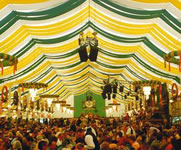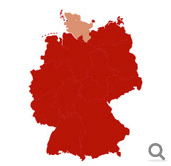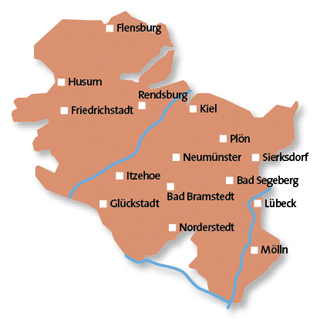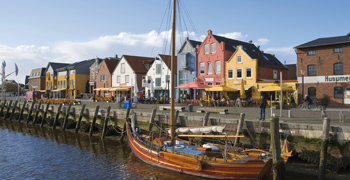
Historical Towns
- Historical towns in Brandenburg
- Cathedral Towns and Cities in Saxony-Anhalt
- The innovative Anhalt-Wittenberg Region
- Enchanting towns in the Harz
- The beautiful towns and cities in Saxony
- Towns and cities of culture in Thuringia
- Beautiful towns of Franconia
- East Bavarian traditional towns
- Alpine towns in the Allg�u
- The eastern Akpine Foothills and their towns
- Towns and villages in the western foothills of the Alps
- Mediterranean towns on Lake Constance
- Towns in the Swabian Alb
- Unspoilt towns in the Black Forest
- Towns for refined tastes in the Heilbronner Land
- Towns in the Odenwald
- Wine towns in Rheinhessen
- Saarland, a region of contrasts
- Romantic towns in the Hunsr�ck and Nahe Regions
- Idyllic towns and villages in the Moselle Region
- The Ahr Rhine Eifel holiday region
- Wine towns on the Romantic Rhine
- Modern towns and cities in the Bergisches Land Region
- The Lahn Valley and its fairytale towns
- Historical towns in Kurhessisches Bergland
- Sauerland's scenic towns
- Fairytale towns in the Weserbergland Hills
- Majestic towns in the M�nsterland Region
- The nine stars of Lower Saxony
- North and East Frisian Islands
- Vibrant Schleswig-Holstein
- Maritime towns along Mecklenburg's Baltic Coast
- Historical Hanseatic Towns
- Germany's Baltic Sea Islands
- The Mecklenburg Lakes
Contact and information
Maritime impressions in Northern Germany adventure by the sea

Husum
Besides the regional capital of Kiel, and the Hanseatic town of Lübeck whose Holsten Gate has now been designated UNESCO World Heritage, Schleswig-Holstein has a number of towns which all have their own distinctive appearance. Take Husum, for example: holidaymakers love to visit this town on the edge of the UNESCO World Heritage Wadden Sea. The sea and the mudflats can be explored on walks along the dykes, and tours led by expert guides who can tell you all about the local wildlife. The North Sea Museum documents the traditions of dyke-building and the reclamation of land and examines the way the people on the coast have learned to live with the forces of nature and the storm tides. The exhibition also explores life on the Hallig islands, the small undyked islands in the North Frisian Wadden Sea. Husum's most famous son is Theodor Storm whose novella Der Schimmelreiter about the dyked area on the North Sea coast has long been a classic of the literary canon. Storm is commemorated with a bust in the grounds of Husum Palace, where more than four million crocuses transform the park into a riot of colour every spring.Hansa-Park
Swoop out like a bird out over the Baltic at Hansa-Park, Germany's only adventure park by the sea, where a new giant rollercoaster is breaking all sorts of records. Ride the cataplector on a spectacular, thrilling adventure, unlike anything you have ever experienced before. Journey through time or a round-theworld trip? Now you don't have to choose: another new Hansa-Park attraction is its themed land on the rise of the Hanseatic League. The park is open from the beginning of April to the end of October.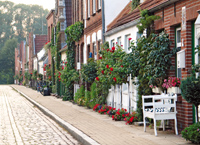
Friedrichstadt
Based on the pattern of a chessboard, the layout of Friedrichstadt is one of the unusual features that makes this Dutch-influenced town so special. Two canals run through the older part of the town, earning it the nickname of the `Venice of the North'. Visit the Fürstenburggraben canal in the south as well as the Mittelburggraben canal, and admire the old buildings whose red brick facades are typical of the Dutch Renaissance style. The medieval houses with their stepped gables and the historical pump on the market square give Friedrichstadt a special charm all of its own, making a stroll through the old quarter a real treat. If you're looking for a place to relax and unwind, head out to the beautiful unspoilt countryside of the Eider-Treene-Sorge river landscape.Monks' Trail
Cyclists prepared to tackle a fair bit of gentle climbing on the Monks' Trail will be rewarded with views across the Baltic as far as Denmark. This 340km route meanders its way across the region known as Holstein's "Switzerland", tracing an arc from Glückstadt on the River Elbe to the island of Fehmarn in the Baltic Sea. The trail links the routes followed by the first Christian missionaries in Holstein with the towns and villages visited by Ansgar, Apostle of the North.Bad Segeberg
One of Bad Segeberg's biggest attractions is a limestone hill which provides the largest natural winter roosting place for bats in Central and Northern Europe. In winter, the caves of the Kalkberg are home to around 20,000 bats. You can get up close to some of them in the Noctalis visitor centre. Bad Segeberg is also known as the venue of the annual Karl May theatre festival, while its architectural gems include the triple-naved, brick-built St. Mary's basilica, widely held to be one of northern Germany's foremost examples of Romanesque architecture. You should also make time for a visit to the Otto Flath art gallery, and a trip to the Great Segeberg Lake to stroll along the lakeside promenade or, in the summer, to hire a boat.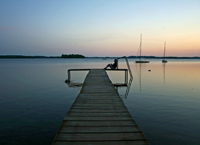
Culinary delights fresh from the sea
Schleswig-Holstein is known for its fish rolls and North Sea prawns. Begin your culinary tour at Glückstadt harbour where you can enjoy a stroll along one of Germany's most attractive promenades while sampling a matjes roll. Only very young herring which have not yet spawned are used to make matjes. The name comes from the local word for girl, meisje. Another favourite of the region is the Kiel sprat, a small herring smoked over beech or alder wood. Those with a sweeter tooth will love the traditional Lübeck marzipan. Made from almonds, sugar and rosewater, this delicacy has been a speciality of the Hanseatic town for almost 500 years.Travel Planner
Select an option...
Romance and charm
Husum Palace is a delightful venue for a wedding. The special charm of the palace is enhanced by the beautiful gardens in which it is set. The palace itself is separated from the rest of the grounds by a small moat.
Food and drink
Café Valentin in Bad Segeberg's pedestrian precinct is wonderfully furnished with a number of antiques. Guests can sample the delicious homemade cakes and gateaux, speciality teas and coffees and seasonal dishes.
History and tradition
Heinrich Rantzau, humanist, European diplomat and governor to the Danish king, had a chapel and an obelisk built in Bad Segeberg to show off the wealth and importance of his monarch. These can still be seen today.
Nature and scenery
The village of Bergenhausen, famous for its storks, is located on the doorstep of Friedrichstadt within the Stapelholmer Landschaft countryside. Up to 14 pairs of storks come to this village every year to raise their young.




